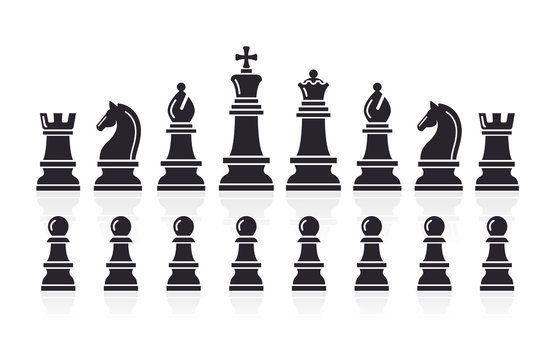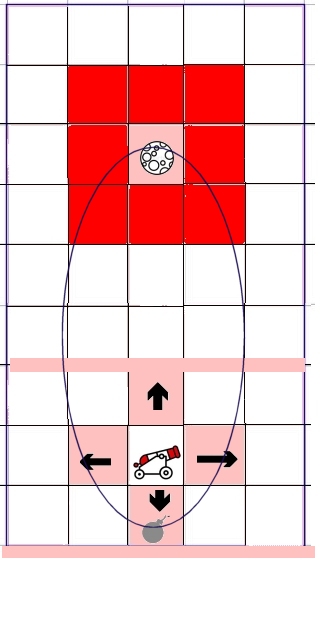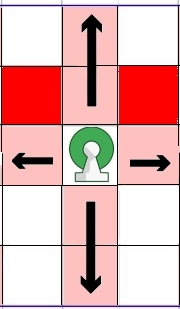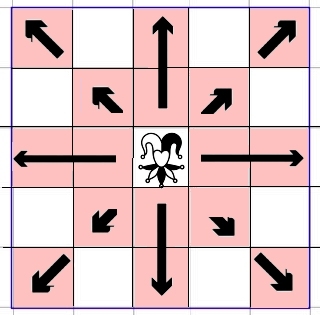chess pieces

The usual chess pieces are all there: KING, QUEEN, KNIGHT, ROOK (tour in french), BISHOP (fool in french) and PAWNS .
They perform as before, but certain features have been disabled:
There is no 'castling' between ROOK and KING
PAWNS can no longer take 'en passant' and PAWNS can no longer be promoted into other pieces when reaching the opponent's base line.
Additional pieces

CANNONS: each side starts with two cannons
A cannon can only fire IF there is amunition in the square just behind it
MOVEMENT: up/down, left/right one square at a time (like the King)
LIMITATION: cannot move beyond its home base (ie 3 rows)
POWER: can fire a shot up to 5 squares ahead. Shot must land on an empty square.
All squares immediately adjacent to target are blown up (ennemy AND friendly troops alike) (potentially 8 squares)
Where the shot has landed, a crater will appear.
It will therefore act as an obstacle as well as a protection. That crater may be left alone or 'taken' by the opposing side.
Both cannons can use a max of 6 shots between them
A cannon with no shots left may still be moved around (to act as obstacle) until it is taken by the opposing side.
Equality, an amunition square, even with no cannons left, may also be moved around.
Cannons and shots cannot 'take' an opponent. But they can be taken.
If the ammunition square is exhausted (empty) it is deemed as vacant.


CANNON BALLS (SHOTS)
So there are a total of 6 maximum shots.
Shots may be used by any cannon available (including those brought on from the reserves).
To be usable, shots must be positioned exactly behind the firing cannon.
A shot must land on an empty square
A shot may not land on another shot/crater (that square is deemed as occupied).
Shots cannot reach (or damage) the opponent's base area as cannons cannot leave their own base and can only fire a max of 5 squares ahead.

The pink squares indicate where the cannon can nove (one square up, down, left, right)
Same for the shots.
But when firing, the shot can be taken up to FIVE squares ahead of the cannon itself and explode in the dark red area.
The damage radius of a shot is a max of 8 squares (all potentially in one go).
All cannons and their ammunition may move vertically or horizontally, but only one square at a time. They can be taken, like any other piece.
They themselves cannot take other pieces (except by firing)


CRATERS
Craters appear where a shot has landed.
The opposing side may either leave it alone and use it as an obstacle/barricade or it may 'take it' (ie repair the square)
Although they cannot move, craters have an effect on the game (obstacle/protection). Only knights, archers (arrows) and other shots may jump (fly) over them.
ELITE PAWNS


Elite pieces take like pawns (forward, 45 degrees angle)
They can move UP or DOWN one or two squares at a time. They can also move sideways (horizontally) but just one square.
The fact that they can move backwards gives them a greater survivability than ordinary pawns.

Their strike range is ONE square, oblique forward left or oblique forward right (marked in deep red here)
Sp they have a potential damage range of two squares.
JESTERS


Jesters are like a mini queen or a strong king: they can move and take in all axes, but only up to two squares. Even so, this range gives then a strike potential of 16 squares.
This flexibility (all axes) makes them one of the most powerful pieces on the board.

ARCHERS

Archers are reserve troops that may be called upon if a side has lost at least 16 pieces (shots and craters don't count).
All four archers may be brought in at the same time. They may be positioned on any free square on the bottom (base) row (ie where the King usually is).
They move vertically and horizontally.
Their vertical movement is up to 5 squares ahead or backwards. Their horizontal movement is 1 square only (left or right). They can take an opponent only vertically and forward.
They can 'fly' over other friendly pieces and craters, but they can only kill the first available opponent and only if said opponent is isolated vertically.
If there is a piece behind that opponent, then it cannot be taken.
I was considering using archers like cannons: stationary but with moving ordnance. This was to respect the notion that it is the archers' arrows that do the damage (just like the cannons' shot do the damage).
In the end I have allowed the archers themselves to do the fighting. This may sound implausible, but it must be noted that rooks (castles) are already moving about and taking pieces.
Initially of course, rooks (towers in french) were actually chariots.
CHANGE OF PERSONNEL (reserves)
It's a bit like subsitutions in football: take a piece off and bring a different one on (not necessarily at the same time).
For instance, if there is only one bishop left in your troops, it may be an idea to remove him and bring on a knight later on.
Or forgo an elite pawn for an extra cannon shot. Or remove a knight and bring on two pawns at some later stage.
Or remove a piece in grave danger of being taken (and get some credit in the process, albeit at the the expense of a lost 'move').
Credits are given for pieces being removed. Cost is incurred (usually higher) for pieces brought on.
Pieces being brought on will automatically be placed on the first available square on your base line (ie line 1 or line 12 where the king usually is)
If there is no place on the base line, you just lose the option.
The King cannot be 'substituted'
FORTUNES OF WAR (chance card)
At some point during the battle, a random event happens which may favour one side or the other.
This is a departure from chess not being a game of chance.
We've introduced this element as in real battles, unforeseen events may have a bearing on the conduct of hostilities (ex abnormally and unexpected severe weather during the Napoleonic campaign in Russia, non-arrival of promised allied reinforcements and so on)
One type of random event may affect pieces on certain squares (for instance pieces on squares 48 and 49 are killed and removed from the board). Another unwelcome event may be the loss of any isolated piece (a piece where all adjacent squares are NOT occupied).
Not all random events are debilitating. Some may procure some unexpected luck, like adding an extra piece to the reserves.
When Napoleon Bonaparte was criticised for winning battles simply because of luck, he famously retorted: “I'd rather have lucky generals than good ones.”
The Queen of Hearts, is the bearer of good news.
The Ace of Spades is the harbinger of bad times.
The JOKER causes unexpected twists including taking the game back 10 moves which may please one side more than the other.



MULTIPLE MOVES (frontal attack)
Several pieces may be moved in ONE GO, providing that:
they are all the same type
they touch each other and form a perfect horizontal line
their movement is FORWARD straight ahead only and there is no obstruction immediately in front of them
the max number of simultaneous pieces is 5 (the starting piece plus 4 to its right)
The following pieces are able to move straight ahead (vertically) in a concerted frontal attack:
pawns (one or two squares ahead)
elites (one or two squares ahead)
jesters (one or two squares ahead)
rooks, cannons, shots and queens cannot do so.
To trigger a frontal attack, CLICK the FRONTAL ATTACK button in the top left section.
Then MOVE the desired piece forward. All eligible pieces to ITS RIGHT will move at the same time.
If during surch a concerted move, an opponent's piece gets taken, then the frontal attack ends immediately.

In the above example, allowed multiple moves are shown in green. Invalid ones are in red.
Five pawns on the left and three on the right are allowed to moved in a concerted attack.
Two elites on the right are OK as well.
The two elites on the left are horizontal alright, but their path is obstructed.
The two jesters are also ineligible because one of them is obstructed.
Frontal attacks are particularly useful in the early part of the contest, but become less and less relevant as pieces are depleted or become scattered on the board.
TWO-PLAYER MODE
First player (whites) clicks on Player Mode in the bottom menu, then selects his avatar.
Second player (blacks) then does the same thing.
When the two avatars appear at the top of the screen, the game can begin (whites go first)
Both players can now see the game as it progresses.
The two players need to use different computers or at least same computer with two different browsers (because cookies are used to recognize them).
Work still in progress.
Future options:
An expanded board 16 squares wide ( 12 rows x 16 columns) This would allow the introduction of more exotic pieces:
SPIES and AMBASSADORS
GUARDS AND SENTINELS
and ...
SUPER ARCHERS.
Alternatively, Archers may move like Kings (one square in 8 possible directions) Unlike cannons, archers don't need to be fed with ammunition. They carry their own.
They have a limitless supplies of arrows.
To shoot an arrow, they have to move ONE STEP FORWARD. Whenever they do that, they are deemed to have released an arrow.
The arrow goes straight ahead and will hit the first isolated opponent (if any).
An isolated opponent is one with an empty square in front and behind him.
So an arrow can fly OVER a friendly piece But not over a foe (the first foe encountered is hit provided it is isolated as explained above).
If there are none, no arrow is released and the archer is deemed to have just moved one square forward.
The following pieces cannot be taken (killed) by an arrow: cannon, shot and rook.